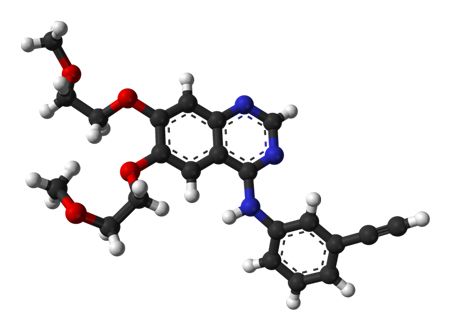Erlotinib Plus WBRT Effective for NSCLC Brain Metastases
The combination of whole-brain radiation therapy and the EGFR inhibitor erlotinib showed a promising response rate and was well tolerated in a new phase II trial of patients with brain metastases from non-small-cell lung cancer.
Chemical structure of erlotinib

The combination of whole-brain radiation therapy (WBRT) and the epidermal growth factor (EGFR) inhibitor erlotinib showed a promising response rate and was well tolerated in a new phase II trial of patients with brain metastases from non-small-cell lung cancer (NSCLC). Results of the study were published online ahead of print on January 22 in the Journal of Clinical Oncology.
“Among patients with NSCLC, approximately 20% to 40% will develop brain metastases at some point,” wrote researchers led by James M. Welsh, MD, of the department of radiation oncology at MD Anderson Cancer Center in Houston. “Radiation increases the expression of EGFR in cancer cells, possibly contributing to the resistance of those cells to therapy.” Because the EGFR inhibitor erlotinib (Tarceva) has shown some ability to penetrate the blood-brain barrier, the investigators hypothesized that combining the drug with WBRT could improve the efficacy of the radiation treatments.
The study included 40 patients, all of whom had brain metastases from NSCLC and who underwent the combined treatment. The overall response rate was 86%; the median survival time in the cohort was 11.8 months, which the authors noted was “almost double the 6 months the study was designed to detect.” The 6-month, 1-year, and 2-year survival rates were 68%, 50%, and 24%, respectively.
EGFR status was known in 17 of the 40 patients, and mutations were present in 9 of those 17. Response rates were higher for patients with EGFR mutations than for those with wild-type EGFR, and survival was also improved. Those with mutations had a median overall survival of 19.1 months, compared with 9.3 months in those with EGFR mutations.
The rate of mutations-9 of 17 patients-was exceptionally high compared with standard, unselected populations of NSCLC patients. This adds to previous hints that patients with EGFR mutations could be more prone to brain metastases than other NSCLC patients; still, that and the promising response rates should be “interpreted cautiously because of the small numbers of patients and lack of randomization,” the authors wrote. There was also the potential for negative selection bias, because MD Anderson tends to treat patients with fewer than four central nervous system lesions with a stereotactic approach.
“Moreover, the use of erlotinib has changed significantly since this trial was begun,” the authors wrote. “Currently erlotinib is approved for use as initial treatment (first-line therapy) for patients with a new diagnosis of EGFR-mutated lung cancer. This usage would presumably lead to outcomes that are different from those for the patients in this trial.” Still, the high survival times associated with the combined erlotinib and WRBT in this trial suggest that larger, randomized trials may be warranted.
Study Details
Of the 40 patients in the study, 17 were male and 23 were female, and the median age was 59 years. Most patients had four or more brain metastases; four patients had stereotactic radiosurgery before the study, and five had such surgery after the study’s conclusion. The median radiation dose was 18 Gy.